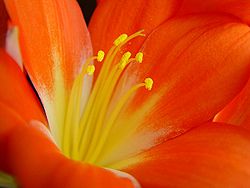| Clivia miniata | |
|---|---|
 | |
| Scientific classification | |
| Kingdom: | Plantae |
| Clade: | Tracheophytes |
| Clade: | Angiosperms |
| Clade: | Monocots |
| Order: | Asparagales |
| Family: | Amaryllidaceae |
| Subfamily: | Amaryllidoideae |
| Genus: | Clivia |
| Species: | C. miniata |
| Binomial name | |
| Clivia miniata | |
| Synonyms [2] | |
| |
Clivia miniata, the Natal lily or bush lily, is a species of flowering plant in the genus Clivia of the family Amaryllidaceae, native to woodland habitats [3] in South Africa (Eastern Cape, Mpumalanga and KwaZulu-Natal provinces) and Eswatini. It is also widely cultivated as an ornamental.









